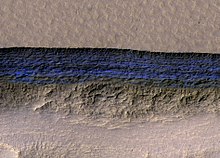World Is Not Enough (spacecraft propulsion)
WINE developed a method of extracting volatiles from ice, ice-rich regolith, and hydrated soils and uses it as steam propulsion which allows the spacecraft to refuel multiple times and have an extraordinary long service lifetime.
This would allow a single spacecraft to visit multiple asteroids, comets or several landing locations at an icy world such as the Moon, Mars, Pluto, Enceladus, Ganymede, Europa, etc.
[1][2][3][4][5] WINE was conceived by planetary research scientist Philip Metzger at the University of Central Florida and Kris Zacny of Honeybee Robotics.
[6][7] The team developed and tested a spacecraft prototype that harvests local water ice "for eternal exploration of space" using steam as propulsion.
[7] The stored water can be heated into steam and used to move the lander's legs as a spider does for walking, or use it as a jet thrust to fly to different landing sites or to travel to multiple icy bodies.
It features a double-walled coring auger with a heated inner wall to extract volatiles from ice, ice-rich regolith, and hydrated soils from icy bodies.
This gas is contained in the system and flows into a cold trap, where it condenses into a solid and can be transferred to a storage tank on another vehicle or depot.
[7] Although the research is funded by NASA, this water-harvesting system is available to private companies to use it on asteroids, comets, the Moon, Ceres, Europa, Titan, Pluto, the poles of Mercury, or anywhere there is water and sufficiently low gravity.


